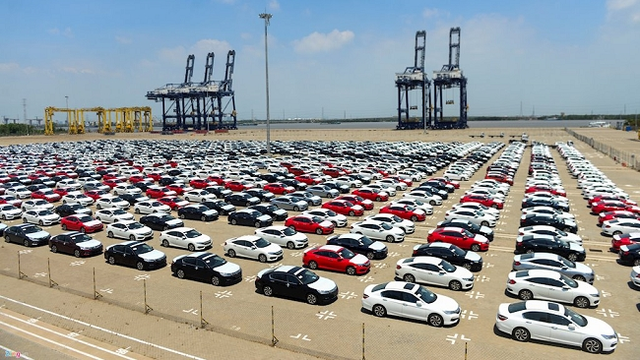 Economy
Economy

 |
| Imported cars wait for custom clearance at a port in Việt Nam. - Photo of vir.com.vn |
HÀ NỘI — Domestic automobile market is currently facing a situation of high supply and low demand. This has resulted in a decline in sales and an excess of inventory for carmakers.
In response, these car manufacturers have resorted to offering big discounts and promotions to attract customers and stimulate demand.
The decline in sales can be attributed to several factors, including the expiration of a government incentive programme that offered a 50 per cent registration fee reduction, as well as the recent Tết holiday. As a result, car manufacturers have been actively reducing prices since the Lunar New Year to entice buyers.
The General Statistics Office's report indicates a significant drop in the output of domestically produced and assembled cars in February 2024 compared to previous months and the same period in the previous year. Similarly, the number of imported cars has also seen a decline.
In February 2024, a total of 21,900 new cars, including domestically produced and imported cars, were added to the market. This figure represents a decrease of 23.3 per cent compared to January 2024 and a decrease of 38.8 per cent compared to February 2023.
The output of domestically produced and assembled cars in February 2024 was estimated to be 15,900 units, which was a decline of 26.4 per cent compared to January 2024. It was also a decrease of 25.3 per cent compared to February 2023, making it the month with the lowest output in recent years.
Cumulatively, in the first two months of 2024, the output of domestically produced and assembled cars was estimated to reach 37,500 units, down 9.8 per cent compared to the same period in 2023.
The number of imported cars in February 2024 was estimated to be 6,000 units, with a value of US$117 million. This represents a decrease of 13.7 per cent in volume and 19.3 per cent in value compared to January 2024.
The total number of imported cars in the first two months of 2024 was estimated to reach 12,955 units, with a value of $262 million. This represents a significant decrease of 51.6 per cent in volume and 54.3 per cent in value compared to the same period last year. This is the lowest number in the past few years.
In total, in the first two months of 2024, there were 50,455 vehicles, including domestically produced, assembled, and imported cars, supplied to the market. However, car sales in the entire market during the same period were estimated to be more than 40,000 vehicles of all types. This indicates that supply exceeded demand by nearly 10,000 cars.
As a result, it was estimated that the car inventory by the end of February 2024 was be around 70,000 vehicles of all types, primarily consisting of cars manufactured in 2023.
To address this situation, businesses have been implementing large-scale promotions and discounts across various car segments.
In the A-class SUV segment, models such as Toyota Raize, Hyundai Venue and Kia Sonnet have seen price reductions of VNĐ20-30 million. In the B-class SUV segment, Hyundai Thanh Cong has announced a price reduction for the Creta model, while Mitsubishi Vietnam has reduced the price of the Xforce model.
Toyota dealers are offering discounts on the Yaris Cross model, while Honda Vietnam is supporting 50 per cent of the registration fee for the HR-V model and providing accessory packages as gifts to buyers.
In the B-class sedan segment, models such as Hyundai Accent, Toyota Vios, Honda City, Mitsubishi Attrage and Suzuki Ciaz are being offered promotional discounts ranging from VNĐ40-86 million. Similar price reductions can be observed in other segments such as C-class SUV, D-class SUV, C-class sedan, and D-class.
Given the current state of the local auto market, it is projected that many car models will continue to experience deep discounts in the coming months to stimulate demand and reduce inventory levels. This is indicative of the challenges faced by the Việt Nam auto industry, which is currently grappling with a recession. — VNS




